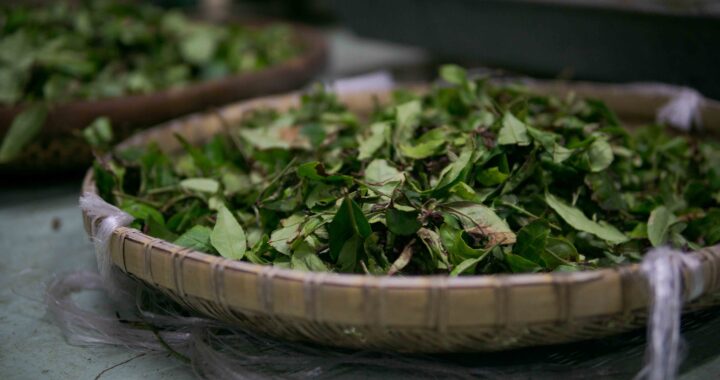Hey there fellow tea lovers,
my name is Till, Intern number #175 and I am currently taking part in a 3-month internship at Kyoto Obubu Tea Farms, where I have the once in a lifetime chance to explore the ways and means of Japanese tea production, including plant care, harvesting, machine processing, as well as hand-processing, which I am very passionate about.
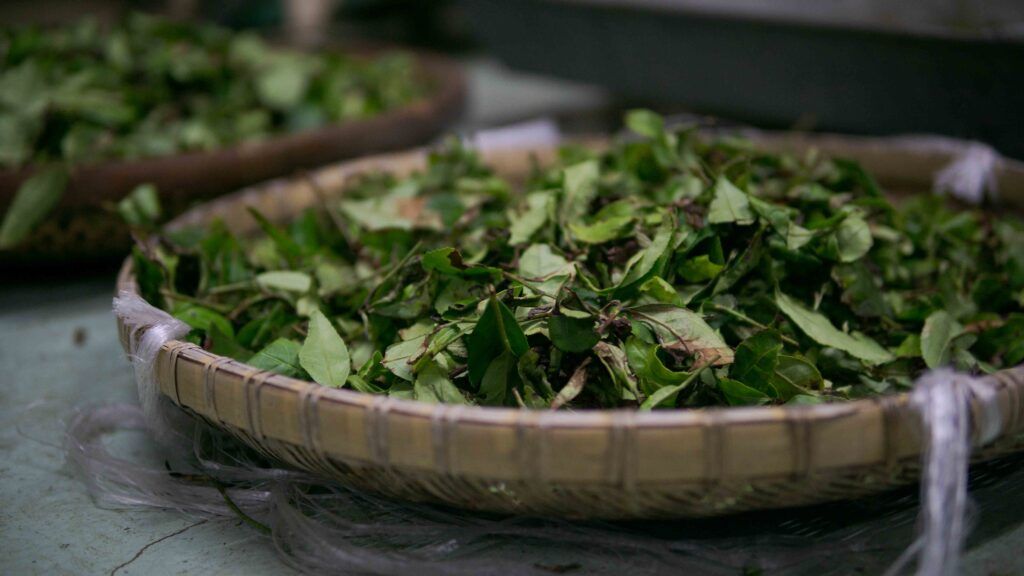
My desire to produce a Wakocha by hand arose during a late-night shift in the factory, where I found a small batch of already sun-withered leaves from Pau’s (Assistant Manager) withered-sencha-project, that was forgotten in a collection compartment of our steaming machine underneath the conveyor belt. The leaves at this point had already undergone approximately 45 minutes of sun-withering, while being spread out on trays and placed in the sun and had been stored in our Houjicha-fridge at around 18°C over night, while being flipped by Pau every two hours. This process left them in a semi-oxidized state, which was the perfect starting point for my first ever handmade Oolong test-project. I then decided to give them a light rolling every once in a while, when there were just a few minutes of break time between different batches, which was followed by firm rolling and pan-firing the tea very slightly (of course at midnight in Obubu house kitchen) and letting it oxidize for 18 hours over night. After final drying, this didn’t produce an Oolong, like I intended, but rather a Wakoucha (Japanese black tea), because the batch ended up being much more oxidized than I had initially planned. Nevertheless, this tea was the first tea, that I produced from harvest to final drying and most importantly did most of the processes with my own hands. Tasting the first sip of this tea, which presented itself with a flavor-profile of that between a Wakocha and an Oolong fulfilled me with deep satisfaction and made me wonder if I could make an Oolong that is much less oxidized in a more “professional” way, following the actual steps necessary to produce a light to medium oxidized Oolong, instead of following a purely intuitive process.
Following my natural interest I researched Black tea-making-techniques and processes both from China and Japan and decided to try a more Yunnan-style Chinese approach, which includes harvesting around 1 – 2 kg of Yabukita, sun withering them for 45 minutes in optimally cloudy weather to prevent them from withering too much and losing too much moisture in the first step of the process, then allowing them to wither indoors for overnight and then start the rolling process, which involves rolling the leaves for 60 minutes in a our small rolling-machine. Rolling should be done with light to medium pressure for 10-20 minutes to break up the cell walls and get the excess moisture to the outside of the leaves, to allow for optimal oxidation. Rolling can either be done on a bamboo tray or in a cotton bag. Final drying can be done either with Kama-Ire (pan-firing), or in a drawer-style drying oven.
At least that was the initial plan…
But after all things most of the times don’t work out as planned. As in this case.
I encountered the first hurdle while withering the batch after harvest. Since the sun was nowhere to find behind the thick layer of clouds hanging over Wazuka, I had to adjust my production process already and decided to only do indoor withering. So I spread out the leaves on a few withering trays and left it on the second floor, hoping that the temperature would stay somewhat warm to encourage proper enzyme-activity in the withering process. So I thought.
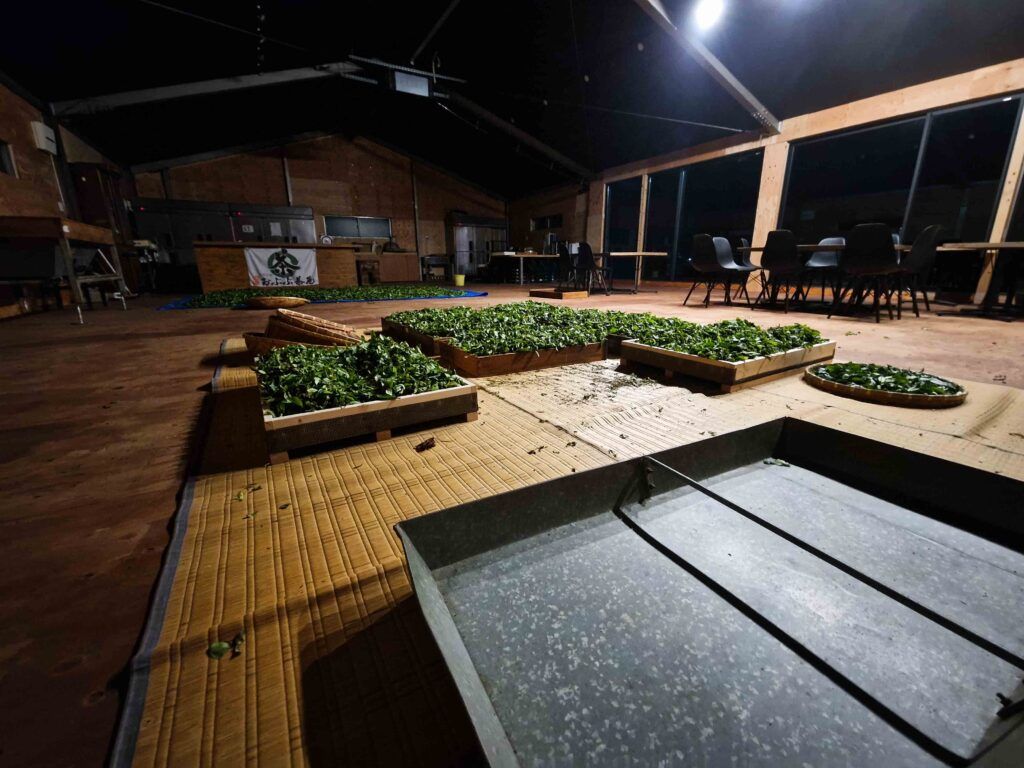
When I came back to the factory on the following day however, I discovered that the AC had been turned on overnight, which resulted in the whole batch cooling down to a temperature at which the enzyme-activity was essentially completely halted. Upon my discovery I decided to put all of my batch out onto a big bamboo-mat, pile it up and cover it with a tarp to retain more moisture and heat. Unfortunately the pile heated up too slowly, so that in an act of desperation I laid down on top of the tarp, that was covering the pile of leaves to heat them up with the warmth of my body and slightly bruise them to encourage new enzyme-activity. To my surprise that actually worked pretty well and the pile was “revived”.
After a while I decided to sort a few mother leaves and those leaves out, that had already lost too much moisture. Since I had to work with 25 kg of leaf-material, I only managed to take out a small tray worth of waste-material.
Since I had other duties to fulfill, my batch had to rest for a few more hours, while I held a lesson on Tea-Chemistry for the Kohai interns, before I could finally start the rolling-process. Rolling took place in the small rolling-machine, that only holds up to 3,5kg of leaf material. After the first batch had been rolled for 50 minutes under altering pressure, the leaf-material already being too dry started to crumble and break up. At this point I made a decision to throw all of my previously made plans out of the window and go down the intuitive route from there, which later turned out to be the exact right decision.
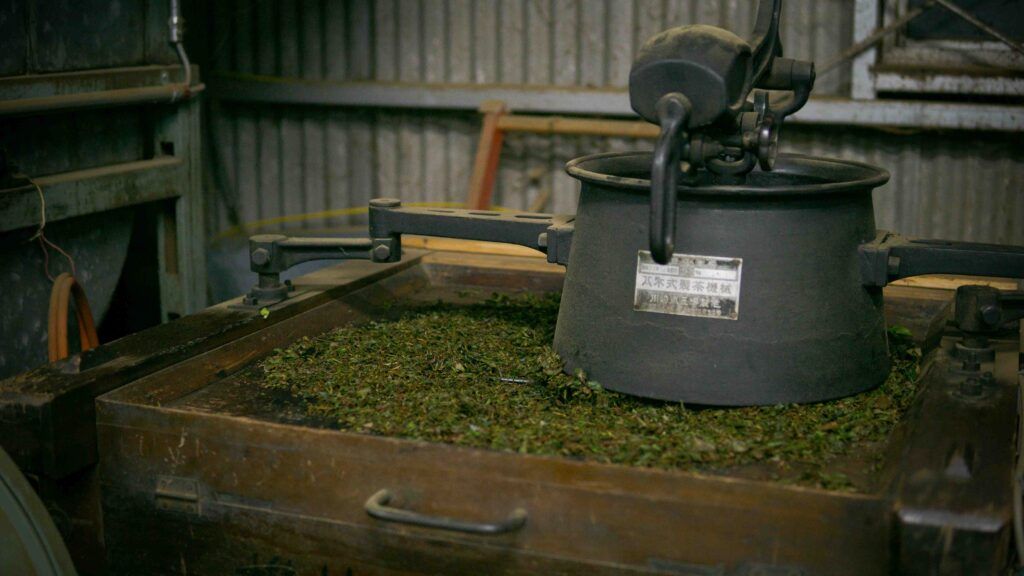
I sifted the broken up first batch to separate the intact leaves from the crumbs and started the second Batch in the small rolling machine. This time I only rolled with very light pressure, to not break the leaves up as much. This approach turned out to produce a much better outcome with such dry leaf-material. Since splitting 25kg of leaf-material up into 3,5 kg batches and rolling them for approx. 1 hour would’ve taken me more than 7 hours, I decided to put the rest into the big rolling machine and continue the processing of the second small-batch by handrolling. I handrolled on and off for multiple cycles, while the big batch was being rolled, until I felt like it was time for the leaves to rest. After the big batch was done, I proceeded to process it in the tumbler-machine for just 6 minutes, to get rid of some of the smaller particles in there. After that I split the batch up into two parts, one of which I then shaped in the shaping machine for around 25 minutes, before finally at one AM calling it a day and going to sleep.
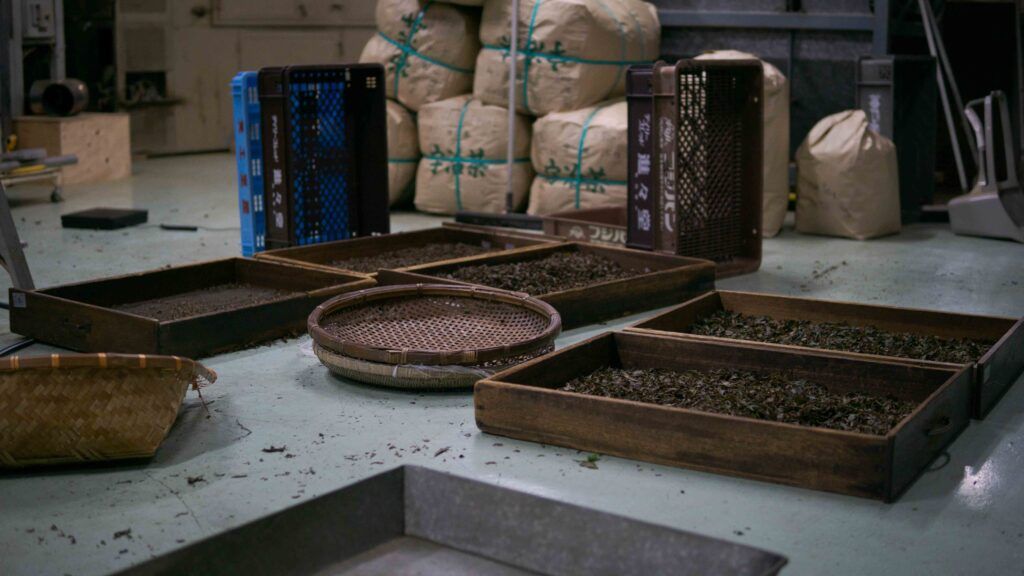
The next day I checked the oxidation-state of the leaves, which at this point had developed a nice withered and oxidized smell, but not yet enough to proceed to drying. So I decided to rest them on the second floor of the factory, where at some point the AC was turned on again, in turn again halting the oxidation of my batch and forcing me to move the whole batch downstairs into the factory, where they rested once more, before I decided to give them another bit of bruising by hand, to break up even more cell walls, thus combining more enzymes and there respective substrates and consequently enabling the batch to oxidate further.
After a few more hours had passed I started drying the first small batches, which were previously rolled using the small machine. At this point the Batches one and two had already undergone a 27:30h withering-process, were machine rolled for 40 – 50 minutes, had been oxidized for around 23h and had been handrolled after the machine rolling took place. With the first batch I kept the drying-temperature farely low, at only 65°C and therefore increased the drying duration to around one hour. After that the Batches one and two were ready to be packed.
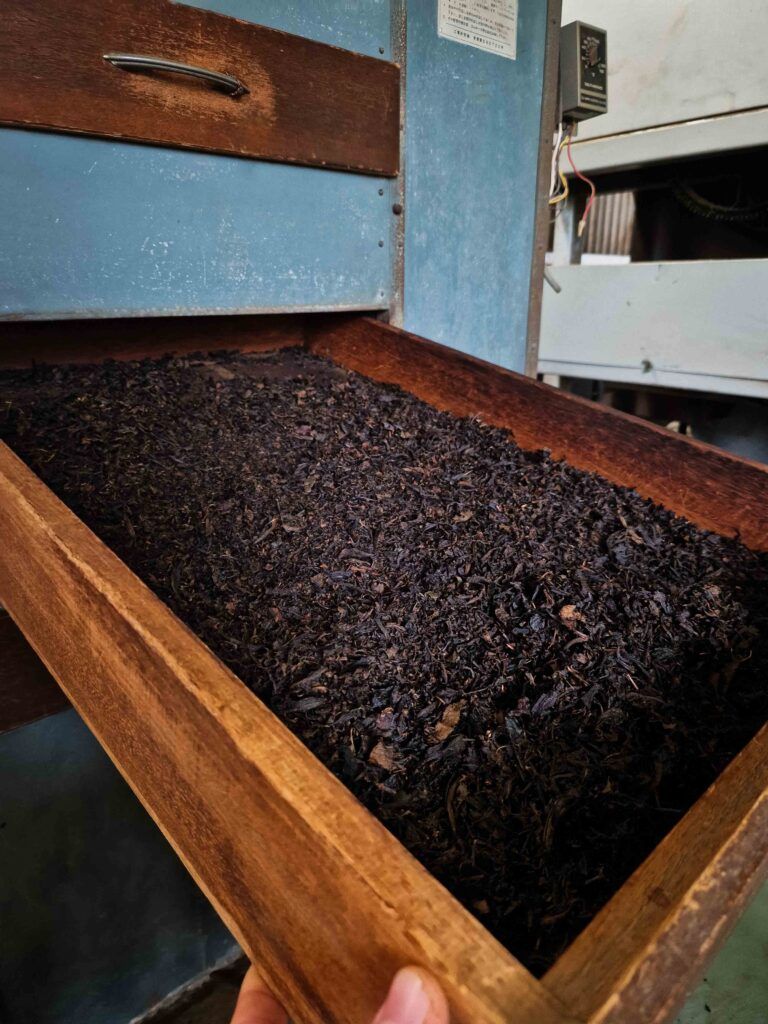
For the remaining two batches, which were rolled in the big rolling machine, I decided to extend the oxidation-time and let them oxidize over night, so I covered them with a tea bag and left them in the hot factory, where Akky-San was processing this seasons Summer-Sun-Sencha. The next day I was struck by the flavor the leaves were releasing after the oxidation had taken place at high environmental temperatures. Both batches turned out to be on the threshold of microbial fermentation, meaning the same process that turns cucumbers into pickels just started to kick in, which made the batches smell slightly acidic. But at the same time the aromas the tea developed over night were incredible. Woody aromas, reminiscend of Bourbon-Whiskey-barrels filled the air and indicated that it was finally time for drying to stop, or at least minimize the oxidation-process, since these aromas were exactly what I wanted to achieve in the first place. To fix, or at least minimize the oxidation-process I started drying at 75°C and worked my way up to 85°C. Since the enzymes that let the leaves oxidize in the first place, called oxidase are denaturalized at around 65°C the oxidation was fixed in the drying process, probably only leaving a very small portion of Enzymes intact, which enables the tea to further age and transform Theaflavins into Thearubigins and eventually to Theabrownins, which are especially found in post-fermented teas, such as Pu-Erh, Goishicha and Awabancha. The fact that my self-made tea might further age and transform it’s flavor-profile further makes me excited to try it in a few months, or even in a few years. Usually the aromas of the tea tend to get deeper and more diverse with ageing.
Trying my teas in a comparative tasting the day after processing enabled me to choose my favorite, which was Batch 3, that with its woody and Bourbon-like notes really stood out and therefore deserves the name “Lumberjacks Delight”.
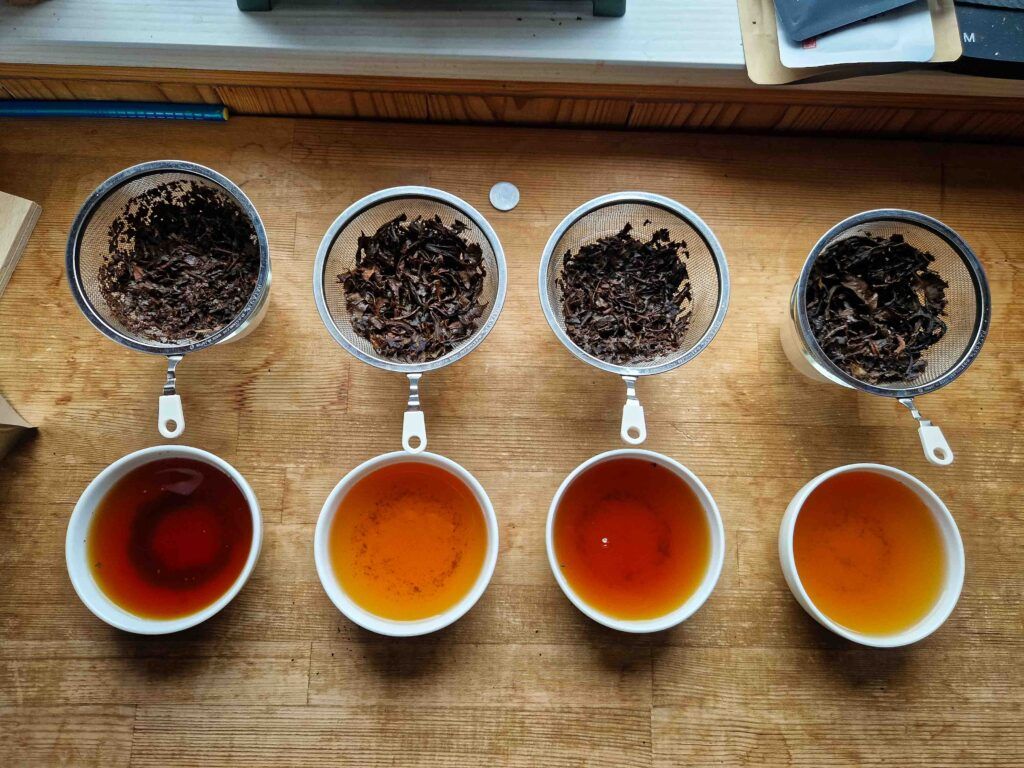
After this incredibly exhausting, challenging, but also incredibly exciting and fulfilling project, I am left in astonishment for what I was able to achieve without any previous tea-making-experience and makes me look forward for the next opportunity to make my own tea, which will hopefully follow very soon.
With this being said, if you should ever have the chance to make your own tea, fear not. The more passion, attention and time you put into it, the better the tea will turn out in the end. That is especially true with oxidized teas, where even the way you shuffle the leaves during withering or oxidation will affect the flavor. For me, making my very own tea on a larger scale than in my little experiments with “pocket-tea”, that I took with me from the fields was a very inspiring and fulfilling process, that I would delve into again, anytime.

